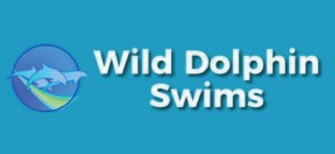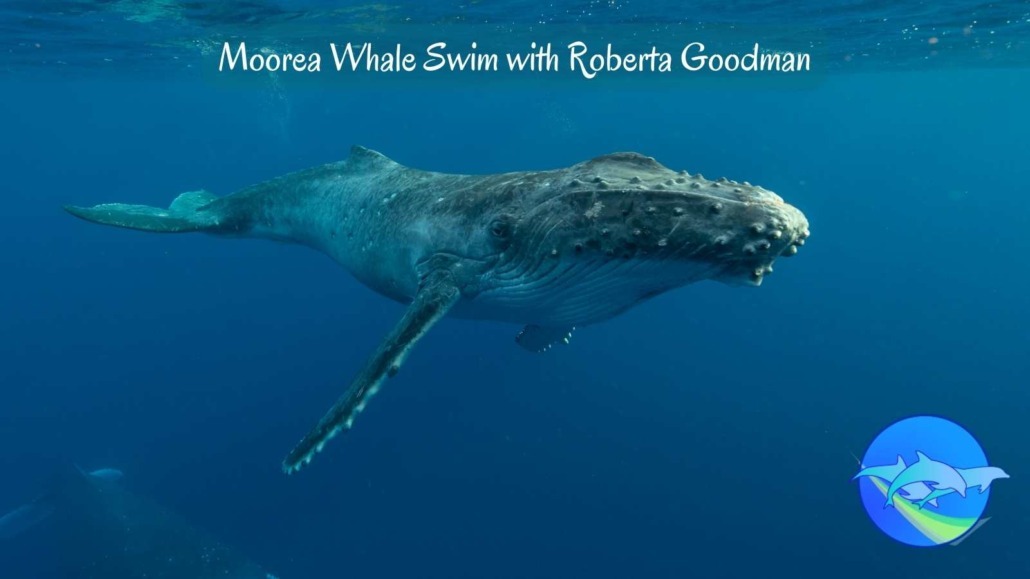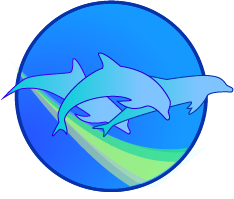Moorea Whale Swim with Roberta Goodman
We meet and swim with Humpback Whales on Mo’orea, French Polynesia, among the world’s most beautiful islands.
Cetaceans, the Great Whales and Dolphins, remain the most advanced nonverbal beings on the planet.
While I long to hear English in my head with dolphins and whales, the signals I feel, hear, and sense from them are nonverbal.
Nonverbal communication is our mode of connecting profoundly with whales. It’s what we’re feeling while listening to their song. It’s how we express our desires as we swim to meet the whales. It’s being receptive and responsive to the being as we approach.
Totally nonverbal communication is a new language we experience and learn in the company of cetaceans.
We’re transported listening to whale song while floating. Finally glimpsing the entire body of a whale underwater is mindbending, so far away from the life forms we know.
Nonverbal communication is usually considered what we can see or hear: body language, vocal communication, sound production such as tail slapping, and bubble blowing.
Nonverbal communication (NVC) also includes what I would define as subtle communication.
NVC is the nature of our dreams and daydreams; our immersion in creativity and artistic endeavors; emotional remembrances sparked by a scent or cries; it’s feelings of love or longing elicited by music.
While embedded in nonverbal communication surrounding and penetrating us, we pay attention to just a fraction of the limitless nonphysical field of reality.
As you become more receptive to and adept in nonverbal communication, it can become incredibly powerful for effecting change in your life.
In the environment of whales, you rely on NVC. This connecting field is seen, felt, understood, played with, and transmitted by whales and dolphins. Nonverbal communication is much more than what I studied in school!
NVC is the way different realities and energy systems interact. “It is total expression, occurring within the mind and in mind-to-mind exchanges.” As examples of nonphysical perceptions, communication may have elements of “vibrations, light, action, and emotion.”
To feel this communication, produce a nonverbal expression of gratitude, or a positive affirmation for your day. Feel how you send these out to the world.
We consciously or subconsciously use NVC to reach out to the whales, to greet them, to ask for interaction, to thank them for their presence, and to say goodbye.
The whales live in a different sort of reality than we were taught, and they are aware of a different energetic system. We interact with the whales’ field.
We experience the ocean’s waves and the whales’ energy around and within ourselves.
The Typical Itinerary
Weather permitting, we take five boat trips out of the lagoon to find and be with the Humpback Whales in the ocean. Boat trips are four hours and begin between 7 and 8 am. The boat is shaded and can hold up to 14 guests with a captain and crew/swim guide. We bring our own gear, towels, wetsuits, water bottles, and snacks.
There’s a chance we’ll see Rough-toothed or Bottlenose dolphins, manta rays, and other species of whales such as Orcas or Sperm whales. The dolphins are shy however. In the shallow, clear lagoon, we will look for stingrays and small sharks looking to be fed.
I bring a hydrophone and speaker. Stopping the boat and dropping it over the side along the way, we listen for singers. If we hear singing, we can move and check if we’re closer. Singers may stay down for 20 minutes. As the sound level increases, we may shut off the motor and plug in a recorder to create a song file we can take home. We wait to see where the whale rises, move closer, and judge if it’s a good time to enter the water. When it’s our moment, we swim to find the whale lying still below, and wait for him to rise.
Dropping over the side of the boat at least 100’ from the whale sighting, as regulations require, we have a long swim, but it’s immersed in whale cries. The Whales breathe while moving and then diving, leaving glassy ‘footprints’ across the surface. We don’t know exactly where he is. And he may not come back up for 20 minutes. We swim without knowing where the whale is. Finally, a glimmering white streak far below in the deep blue sea.
Looking for a whale in the deep blues, the first sign we see is a pair of white stripes below us. Gradually our eyes adjust to the dimness, and we discern an outline, a whale body. We may even find a second whale juxtaposed nearby. Figuring out which way the whale is pointed, we snuggle together on the surface to the front of his head, peering down. If he’s a singer, we swam through his song to reach this point, and now bathe in song vibrations. We float, relaxed, and wait. While floating with the still whales, sun beams like search light scanning the deep, radiate in the dark blue. Almost unperceptively, the whale form draws upwards, slowly emerging in more detail. He rises exactly below us. The excitement grows as we realize he’s on his way up.
Suddenly he’s there –his enormous head, his wide open eye. This is one of those moments we imagined coming true. Time speeds up as the whale breaks the surface beside us, takes a breath. We absorb his immensity and gentleness. He moves smoothly beside us and takes us all in. He almost lingers, his tail gives him a push, and he glides away. Our group coalesces, heads pop up, incredulous joy on faces and in hearts. Several breaths and 100 yards later, he resumes singing as he dives.
Experiences like this are why we are here. It’s why we face the challenge of traveling and swimming so far. Sometimes we have the energy to follow in the whale’s footprints, with hopes to hang out with the immense being in stillness and song again, until he rises.
Swimming to the Whales
A new baby whale breathes every 2 ½ minutes. As it quickly grows, so does the time in between breathing cycles. On the third or fourth cycle, Mom joins Baby to breathe together. Even if Mom and Baby have been in the same spot, when Mom comes up to breathe, she carries Baby away, 100 yards/meters or so.
We will swim again to rejoin them. The boat dropped us off 100 yards away, so these are minimum swim distances. On a long swim with my group of nine women, I imagined the baby looking me in the eye. That’s what I saw in my mind’s eye, Baby Whale approaching and Baby’s eye.
I swim easily, the baby whale’s eye clear in my mind, and introduce the group by remembering each woman’s faces with a recollection of their eagerness and swim ability, or little-ability. Our desire is strong, our pace smooth, while observing the sunbeams below. Heads down, we keep stroking our fins, trying without splashing, arms at our sides.
A pod of tadpoles, newly born into water, newbies to the Whales’ energy. “Little One,” I call gently, silently, “come see who we are. We’re here just for this, to see you, to know who you are.”
Other groups are already in the vicinity of the whales.
My women cluster in an arc around the mom 30’ below. Together with the other groups, we are in a circle and the baby is on the far side. The baby whale, calf, charges past us all. It happens in a flash.
A second time round, Baby passes slowly by each member of my group. I am at the end. The baby’s eye is as I imagined, wide open in reception. We are stroked by her energy as she swings around, transfixed with her momentary gaze at each of us. She turns towards the center and, with her back to me, she flaps her floppy tail on the surface. A froth of bubbles obscures our view and she disappears entirely for a moment before the bubbles scatter on the surface.
These moments, and the exhilaration which follows, are why I’m leading another group to encounter the magnificent Humpback Whales of Mo’orea.
Won’t you join me?
Roberta



Leave a Reply
Want to join the discussion?Feel free to contribute!